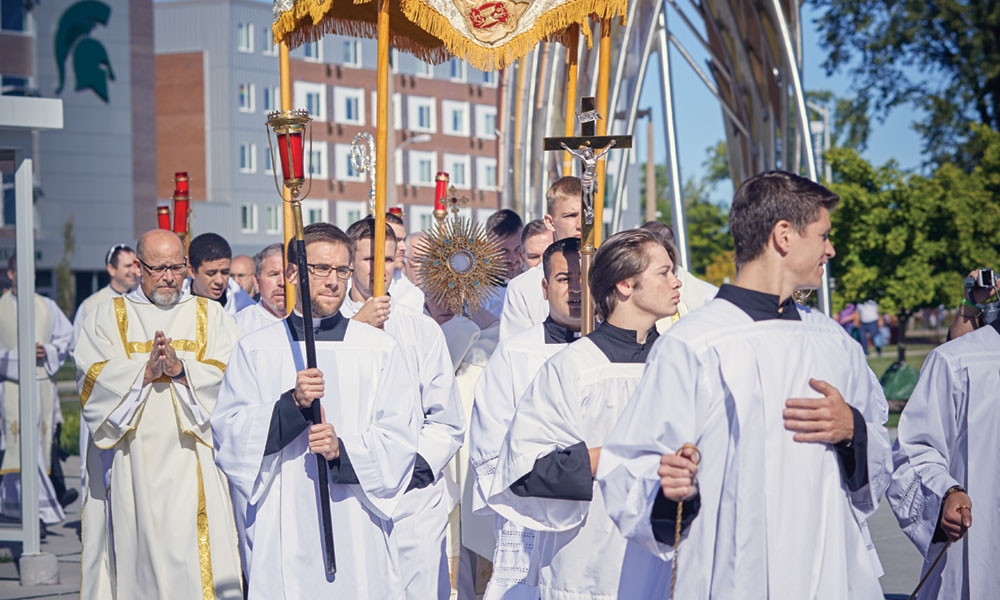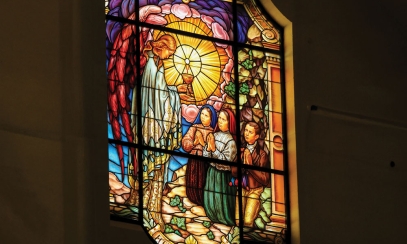
The origins of the feast of Corpus Christi
A procession of love
A procession of love
Getting your Trinity Audio player ready...“You have put me in the depths of the pit,
in the regions dark and deep.
Your wrath lies heavy upon me,
and you overwhelm me with all your waves.
You have caused my companions to shun me;
you have made me a thing of horror to them.
I am shut in so that I cannot escape;
my eye grows dim with sorrow.
Every day I call upon you O LORD;
I spread out my hands to you.
Do you work your wonders for the dead?
Do the shades rise up to praise you? (Psalm 88:6-10)
“You have put me in the depths of the pit,
in the regions dark and deep.
Your wrath lies heavy upon me,
and you overwhelm me with all your waves.
You have caused my companions to shun me;
you have made me a thing of horror to them.
I am shut in so that I cannot escape;
my eye grows dim with sorrow.
Every day I call upon you O LORD;
I spread out my hands to you.
Do you work your wonders for the dead?
Do the shades rise up to praise you? (Psalm 88:6-10)
The words of Psalm 88, read aloud by a nearby pilgrim, echoed in the chamber where we viewed the stone pits prisoners would be lowered into while awaiting trial in ancient Jerusalem. Archeologists believed this was the dungeon where Christ spent his last night awaiting trial, and for me, this was one of the more memorable stops during my pilgrimage to the Holy Land because you can’t help but reflect on the loneliness of Christ during his Passion.
In modern times, there is a Church built above this ancient dungeon, named St. Peter, in Gallicantu, which commemorates the rooster’s crow upon Peter’s denial of Christ. Just outside the church, archeologists discovered ancient steps and a street. At the time of Christ, it would likely have been the only route from the Upper Room, where the Last Supper took place, down through the Kidron Valley, and up the side of the Mount of Olives to the Garden of Gethsemane, where he was eventually arrested. At the end of every Holy Thursday Mass, we commemorate that walk with a Eucharistic procession from the Church to an “altar of repose” somewhere nearby. During the procession, we sing songs and chants in imitation of Jesus and the Disciples who sang on their journey to the Garden. The Eucharistic procession is our chance to accompany him and comfort his sorrowful heart as he enters into his Passion.
Twelve hundred years after the Passion of Jesus, a holy nun in Liège, Belgium, St. Juliana of Cornillon, received a vision of Jesus asking for a special feast honoring the Blessed Sacrament, which he instituted at the Last Supper. She shared the details of this vision with the Archdeacon of Liège, Jacques Panteleon who enthusiastically believed her, and in 1246 the feast of Corpus Christi was inaugurated in the Diocese of Liège. Later on, the archdeacon was elected Pope Urban IV. Early in his papacy, the new pope learned of a Eucharistic miracle in the town of Orvieto. During Mass, a priest doubted the real presence of Jesus in the Eucharist and, immediately, the host started bleeding!
The pope took this as confirmation of the feast of Corpus Christi and instituted it for the universal Church. This new feast needed new prayers for the Mass and new songs, so the pope asked St. Thomas Aquinas to compose these. More well known for his academic precision in theology, St. Thomas also showed his poetic skills, as these prayers and hymns are some of the most beautiful in our whole tradition. The hymn he wrote, Pange Lingua, was considered so beautiful that not only is it sung on Corpus Christi, but it is also the song sung during the Eucharistic procession on Holy Thursday, and if you’ve ever been to adoration and benediction, the last two verses, the Tantum Ergo, are sung.
In the intervening years, the practice of processing through the streets during the feast of Corpus Christi sprang up everywhere, and people witnessed their belief in and love of Jesus publicly, for all the world to see. In various cultures these processions have taken on numerous practices, music, costumes, etc. But in every case, the procession is an act of devotion. It expresses our desire to be with Jesus and to follow him wherever he leads us.
It’s normal to make public declarations when you are in love. We tell our friends when we start dating someone new, lots of pictures and celebrations take place for an engagement, and generally, we get married in front of hundreds of family and friends. Love doesn’t generally stay private. Our love for Jesus should be no different! Joining in a Eucharistic procession around the feast of Corpus Christi is a great way to declare to the world around you, “This is the one I love!”
This year, there will be a special opportunity to make that declaration. On Saturday, June 21, at 10 a.m, there will be a special Mass at Lugnuts baseball stadium in Lansing, followed by a diocesan Eucharistic procession to the cathedral. Come! And bring your family and friends.
The procession on the feast of Corpus Christi is our chance to reverse the loneliness and sorrow of Jesus on Holy Thursday. Instead of walking those ancient stone steps while being abandoned and abused, he now leads a procession of glory, with the Church following in love and adoration. Come and be a part of that joy.
Richard Budd is the Director of Marriage and Family Life Ministry for the Diocese of Lansing.



